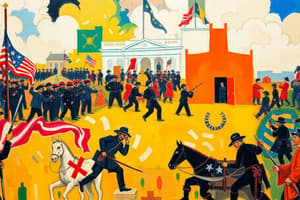Podcast
Questions and Answers
What did Lincoln say?
What did Lincoln say?
A house divided cannot stand
What is secession?
What is secession?
The withdrawal of eleven Southern states from the Union in 1860 which precipitated the American Civil War.
What is the Antebellum Period?
What is the Antebellum Period?
The era between the War of 1812 and the Civil War.
What is sectionalism?
What is sectionalism?
On what topic were the states divided?
On what topic were the states divided?
What was the market revolution?
What was the market revolution?
What is an agrarian society?
What is an agrarian society?
What does 'King Cotton' refer to?
What does 'King Cotton' refer to?
What was the Missouri Compromise?
What was the Missouri Compromise?
What does M&M stand for in this context?
What does M&M stand for in this context?
What does 36:30 refer to?
What does 36:30 refer to?
What was the Compromise of 1850?
What was the Compromise of 1850?
What was the Gag Rule?
What was the Gag Rule?
What was the Fugitive Slave Act?
What was the Fugitive Slave Act?
What did the Kansas-Nebraska Act of 1854 do?
What did the Kansas-Nebraska Act of 1854 do?
Flashcards are hidden until you start studying
Study Notes
Sectionalism in U.S. History: Definition & Conflict
- "A house divided cannot stand" - Lincoln's famous phrase indicating the necessity for unity.
- Secession refers to the exit of eleven Southern states from the Union in 1860, which led directly to the American Civil War.
- The Antebellum Period spans from the War of 1812 until the Civil War, characterized by significant societal changes.
- Sectionalism represents regional loyalty over national allegiance, contributing to the civil war between the North and South in the early 1860s.
- The primary divisive issue among states was slavery, which deeply influenced sectional interests.
- The Market Revolution emerged in the early 19th century, emphasizing technology, factories, and wage labor particularly in the North.
- Agrarian Society pertains to economies based on agriculture, focused on crop production and management of farmland.
- "King Cotton" denotes cotton as the South's predominant export, pivotal to its economy.
- The Missouri Compromise allowed Missouri to enter as a slave state, while Maine was established as a free state to maintain political balance.
- The acronym M&M represents Missouri (slave state) and Maine (free state).
- The 36:30 line served as a geographic division between slave and free states; new states below the line permitted slavery, while those above did not.
- The Compromise of 1850 admitted California as a free state, enforced the Fugitive Slave Act, banned slave trade in Washington D.C., fragmented Texas territory, and introduced popular sovereignty in the Mexican Cession area.
- The Gag Rule was a congressional measure that prohibited consideration of any petitions to end slavery.
- The Fugitive Slave Act permitted slave owners to recapture escaped slaves in the North without granting them a trial by jury; aiding a runaway slave could lead to penalties.
- The Kansas-Nebraska Act of 1854 established the territories of Kansas and Nebraska, effectively revoking the Missouri Compromise by allowing states to choose whether to permit slavery.
Studying That Suits You
Use AI to generate personalized quizzes and flashcards to suit your learning preferences.




